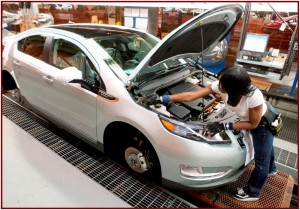
Volt is the world’s most popular plug-in hybrid. Competitive vehicles, notably the Toyota Prius plug-in, arrive this year. There is also a large array of 40 mpg gasoline cars on the market at half the - $40,000 to $46,000 price.
General Motors will lay off 1,300 UAW workers at the Detroit Hamtramck plant where the Chevrolet Volt and its Opel Ampera clone are assembled. Production of the expensive electric vehicle will be suspended from 19 March to 23 April. The plant has been down before as Volt sales aren’t strong, except among a small number of so-called early adapters.
The announcement of the setback to employees came Thursday after GM released February sales results that showed 1,023 Volts were sold in the U.S. GM has sold 1,626 Volts so far this year. Earlier in the day, a Chevrolet sales executive claimed that Volt sales would pick up now that it is approved for California HOV lanes and tax credits as a plug-in hybrid. (See Chevrolet Volt EVs on Way to California. Volts now Qualify For HOV Lanes and a $1,500 State Taxpayer Subsidy)
GM had planned to build 60,000 Volts this year even though in 2011, Chevrolet sold 7,671 falling short of its original goal of 10,000. Aside from its high $ 40,000 starting price and limited 4-seat interior room, the Volt brand was damaged when it became embroiled in politically motivated Congressional hearings over its safety. (Volt Fire Hearings Pits Ideologues versus Engineers)
NHTSA, the world’s most prominent auto safety agency set an unusual precedent back in November by opening a safety defect investigation without any supporting data from real-world Volt incidents. (See also NHTSA Closes Volt Battery Fire Investigation with No Recall)
In the end, how you view this low-voltage Congressional short circuit – with lots of political smoke but no fires – depends on how you view Obama Administration actions that used taxpayer-funded subsidies to encourage production of the Volt. These include $151.4 million in stimulus funds for LG Chem, which produces lithium-ion polymer battery cells for the Volt and $105 million given directly to GM, as well as an end-user federal tax credit of up to $7,500 per Volt purchased. Such subsidies are being debated for all industries during the election.
An annoyed General Motors Chairman, Dan Akerson, said to the committee, “Unfortunately, there is one thing we did not engineer. Although we loaded the Volt with state-of-the-art safety features — we did not engineer the Volt to be a political punching bag. And that, sadly, is what it’s become. For all of the loose talk about fires, we are here today because tests by regulators resulted in battery fires under lab conditions that no driver would experience in the real world.”
Testimony during the hearings said that an average of 278,000 cars with gasoline engines caught fire in the U.S. each year between 2003 and 2007, according to the National Fire Protection Association.
The limiting factors in Volt sales predictions include the expense of the 16-kWh lithium-ion battery pack, and the decidedly uncertain future of taxpayer incentives for its purchase – currently $7,500 at the federal level with thousands more potentially available in some states and localities – as the U.S. budget deficit soars to unsustainable levels, requiring taxpayers to borrow 42 cents for every dollar spent.
The Volt sales reality is that while consumer research indicates that saving the cost of fuel is overwhelmingly the predominate reason people give for considering a “Green” machine such as the Volt, the initial cost is too high and the payback too long – if there is even one for the original or subsequent owners – to translate this expressed desire into an actual purchase. (See Why “Green” Alternative Vehicle Sales Will Remain Limited)
The Volt has the fuel economy (but less interior space) than numerous compact and mid-size cars selling for half the price, including Chevrolet’s own Cruze and the upcoming 38 mpg Malibu, which is much larger. (See Chevy Volt has MPGe Rating of 93, 37 MPG Combined)

